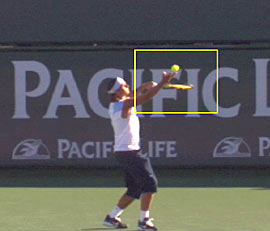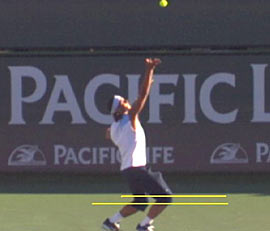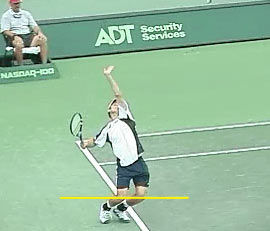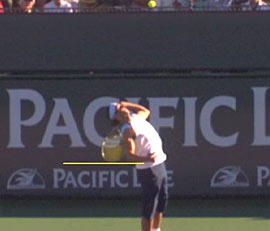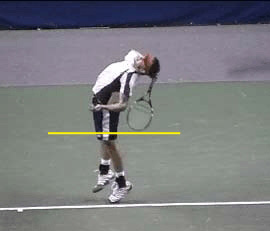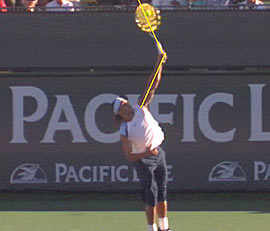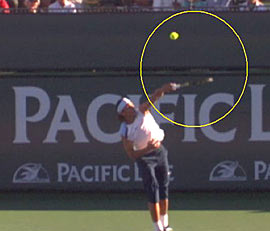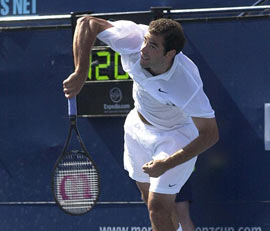|
TennisOne Lessons Rafael Nadal, A Work in Progress Jim McLennan Now we have a tennis rivalry like Connors vs. Borg, McEnroe vs. Lendl, Navratilova vs. Evert, Sampras vs. Agassi. In each case, these compelling matchups kept me riveted, totally engaged as a spectator, often on the edge of my seat as the match reached its fever pitch climax. Certainly these matches were not always barn burners, but the opponents were so evenly matched, with complimentary skills as in the Sampras serve against the Agassi return, or Martina rushing the net with the implacable Chrissie patrolling the baseline.
As the tennis sages consider whether Roger Federer may be the best player to ever grace a tennis court, better than Laver, better than Borg, better than McEnroe, we have a teenage sensation who has beaten Federer three times already in 2006. And what a matchup this is. Nadal plays well behind the baseline, retrieves everything, absolutely deadly when out of position and on the run. He's a combination of the tenacity we saw with Jimmy Connors and the brutal efficiency of the player whose record he is poised to beat, the Hall of Famer Guillermo Vilas. And on the other side of the net, the elegant, balletic, every shot in the book Roger Federer. His creativity and feel for the ball and the game continue to astound. Four sets and a tiebreaker victory for Nadal in Monte Carlo, now five sets and a tiebreaker victory in Rome, Federer is getting close, but on clay Nadal for the time being appears invincible. But go back in the day, when the unflappable Bjorn Borg captured six French Open titles. Unerring consistency, impenetrable will, playing with a mental focus unseen before or since (perhaps). But, it must be said, Borg also captured five consecutive Wimbledon’s – as in five years in a row. The guy could play on dirt and on grass, but what carried him across the lawns of Wimbledon was an excellent serve, not as big as Roscoe Tanner, not as wicked as John McEnroe, but a big and accurate serve. His coach, Lennart Bergelin likened Borg’s serve to “shooting arrows,” and I take that to mean Bjorn’s serve was swift and on target. Now fast forward to the kid who keeps beating Federer, his serve is adequate, he places the ball into the corners, not looking for free points but rather initiating yet another grinding rally. Could he improve his serve? Definitely. Will he improve his serve? Time will tell. But were his serve to approach the punishing efficiency of his ground game, I believe this kid could threaten on the grass, and then can you imagine a five set thriller between these two guys similar to the feast they served at the recently completed masters series tournament in Rome. I had the opportunity to watch Nadal up close at the Pacific Life Open, practicing, and playing both singles and doubles. On both overhead and serve, he appeared to muscle the ball ever so slightly (who wouldn’t with his physique) but I believe in the following stills and video we can see a few spots where he might improve his delivery.
Pancho Gonzalez, revered to have had perhaps the best serve in the history of tennis (that is until Sampras came along), has said that when mastered, “The eastern backhand service grip enables a server to hit with spin, speed, and disguise.” And to me, Nadal’s delivery lacks both speed and disguise, when compared to Sampras, to Federer, or to Bjorn Borg. Toss: Arms up Together On the toss (Figure 1), Nadal brings both arms up. Consider this more a stylistic idiosyncrasy than a divergence from the more common rhythmic windup. He turns his back to the receiver, with his tossing arm positioned parallel to the baseline (as do all the modern big servers). His eyes are up into the contact zone prior to release of the toss. Note how the racquet head is lagging parallel to the ground, his wrist and arm appearing loose. You may want to experiment with this, and material from Vic Braden reinforces a similar racquet position, something like drawing back a football prior to a long forward pass. In fact, the hand at this moment is on top of the football, or in the Nadal sequence his palm is facing down as well. Knee Bend: Weight not Evenly Distributed As he moves into his knee bend (Figure 2), note the two lines showing his kneecaps at different levels.
Years ago, sitting with former Andy Roddick coach Tarik Benhabiles at the Siebel Open in San Jose, he told me Roddick generated his incredible racquet speed from a “dual knee bend.” And he elaborated that many of the servers bend their knees but do not distribute their weight evenly at the bottom of this drop. We see something slightly different here where it appears Nadal is not balancing nor maximizing the force of his knee bend. When capturing Sampras or Federer or even Borg at a similar moment, we would see the knee caps level, both legs equally bent and equally weighted prior to the explosion up and into the hit. When trying this at home, the easiest experiment is to stand at the baseline readying to serve, and then jump up and down three times and on the fourth attempt, jump more forcefully. You will find that you instinctively center, balance, and drive equally with both legs. The same goes, or should go, with the serve.
Swinging Drop As Nadal prepares to launch up and into the hit (Figure 3), the racquet is dropped in the classic position, as though he is pulling the racquet up and into the sky. Don Kerr called this, “throwing a dart” in the ceiling. But compare this picture with those generated by Pete or Roger, or certainly Andy, there we see the tip of their racquet head much, much lower.
Years ago I paid a photographer to take hundreds of photos of Pete at an exhibition in Reno, and a number of photos showed the tip of the racquet actually as low as the bottom of Pete’s shorts. Really! And the lower the racquet drops, the further it has to accelerate up and into the hit. To improve in this area, whether it is Rafael or you and I, the trick is to stay loose as the racquet drops; Braden calls it “going spaghetti.” And I believe that even the slightest intention to muscle the ball inhibits this drop, and ultimately reduces racquet head speed. Serving Tall Impact is pretty good (Figure 4). Nadal is well extended, his eyes are up, and his arm is slightly to his left with the racquet slightly to his right. All the good servers make contact in a similar position, yet somehow this “arch” is misunderstood. Many recreational players place the arm more or less vertical with the racquet positioned up above the arm at impact. They are serving as tall as possible, but this reduces power. With the racquet “off line” with the arm, there is more leverage when the arm swivels into the hit. Muscling at the Top of the Swing But here is the telltale photo (Figure 5). Nadal has powered his racquet and his arm through the hit. But I believe this photo and more so the video indicate that his hand and arm speed diminish racquet speed.
Consider cracking a bull whip, or even a wet towel. The trick is to get the whip or towel swinging, and then abruptly stop the hand, even yanking it back ever so slightly, to crack the tip of the whip or towel. On the serve, with Pete, or Roger, or Bjorn, one would see a sharp inverted “V” at the top of the swing, the hand lingering up with the racquet snapping through and then down. Mind you that Nadal’s serve is pretty darn good. Note that both Agassi and Evert had the hand and arm in a similar position at this moment, but it truly indicates muscling. And when you consider Federer’s aces, they come from both placement and disguise. But with Nadal there is less disguise when the serve is stroked rather than whipped to the corners of the service box. For when you stroke a ball, the hand moves through the contact zone and gives subtle clues to the receiver, but with a whipped stroke there are far less clues and cues as to the target line (recall Goran Ivanisivec, Roscoe Tanner, John McEnroe or, and this is going way back, Arthur Ashe).
The mystery of tennis, and one of the reasons we keep coming back to the game, is that of the multitude of skills employed, some are easier than others for you and I to learn. I see players who can feel and master the semi-western forehand but search endlessly for a crisp forehand volley (Roddick). Players who took the ball early off both wings but never really had a big serve (Jimbo), in spite of being tutored by Pancho Gonzalez (and this is a mystery I have yet to unravel). And certainly there are just as many stories from the recreational courts as well. But the challenge will always be there, to be a student of the game, willing to experiment, willing to tinker (thanks Kevin Kaiser), willing to grow. Let’s see where Nadal goes with all this, if he is breaking all the clay court records, just imagine an assault on Borg’s Wimbledon record. After all, the Kid is a fighter, from tip to toe. Your comments are welcome. Let us know what you think about Jim McLennan's article by emailing us here at TennisOne.
|
||||||||||||||

